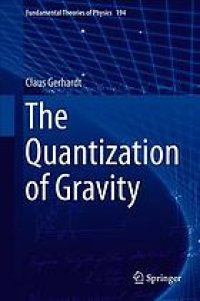
Ebook: The quantization of gravity
Author: Gerhardt Claus
- Genre: Physics // Quantum Physics
- Tags: Quantum gravity., Gravity -- Measurement., Standard model (Nuclear physics), SCIENCE / Mechanics / General, SCIENCE / Mechanics / Solids, Relativity physics., Mathematical physics., Quantum physics (quantum mechanics & quantum field theory)., Gravity., Physics., Classical and Quantum Gravitation Relativity Theory., Cosmology., Mathematical Physics., Elementary Particles Quantum Field Theory.
- Series: Fundamental Theories of Physics 194
- Year: 2018
- Publisher: Springer
- Language: English
- pdf
A unified quantum theory incorporating the four fundamental forces of nature is one of the major open problems in physics. The Standard Model combines electro-magnetism, the strong force and the weak force, but ignores gravity. The quantization of gravity is therefore a necessary first step to achieve a unified quantum theory. In this monograph a canonical quantization of gravity has been achieved by quantizing a Read more...
Abstract: A unified quantum theory incorporating the four fundamental forces of nature is one of the major open problems in physics. The Standard Model combines electro-magnetism, the strong force and the weak force, but ignores gravity. The quantization of gravity is therefore a necessary first step to achieve a unified quantum theory. In this monograph a canonical quantization of gravity has been achieved by quantizing a geometric evolution equation resulting in a gravitational wave equation in a globally hyperbolic spacetime. Applying the technique of separation of variables we obtain eigenvalue problems for temporal and spatial self-adjoint operators where the temporal operator has a pure point spectrum with eigenvalues $lambda_i$ and related eigenfunctions, while, for the spatial operator, it is possible to find corresponding eigendistributions for each of the eigenvalues $lambda_i$, if the Cauchy hypersurface is asymptotically Euclidean or if the quantized spacetime is a black hole with a negative cosmological constant. The hyperbolic equation then has a sequence of smooth solutions which are products of temporal eigenfunctions and spatial eigendistributions. Due to this "spectral resolution" of the wave equation quantum statistics can also be applied to the quantized systems. These quantum statistical results could help to explain the nature of dark matter and dark energy